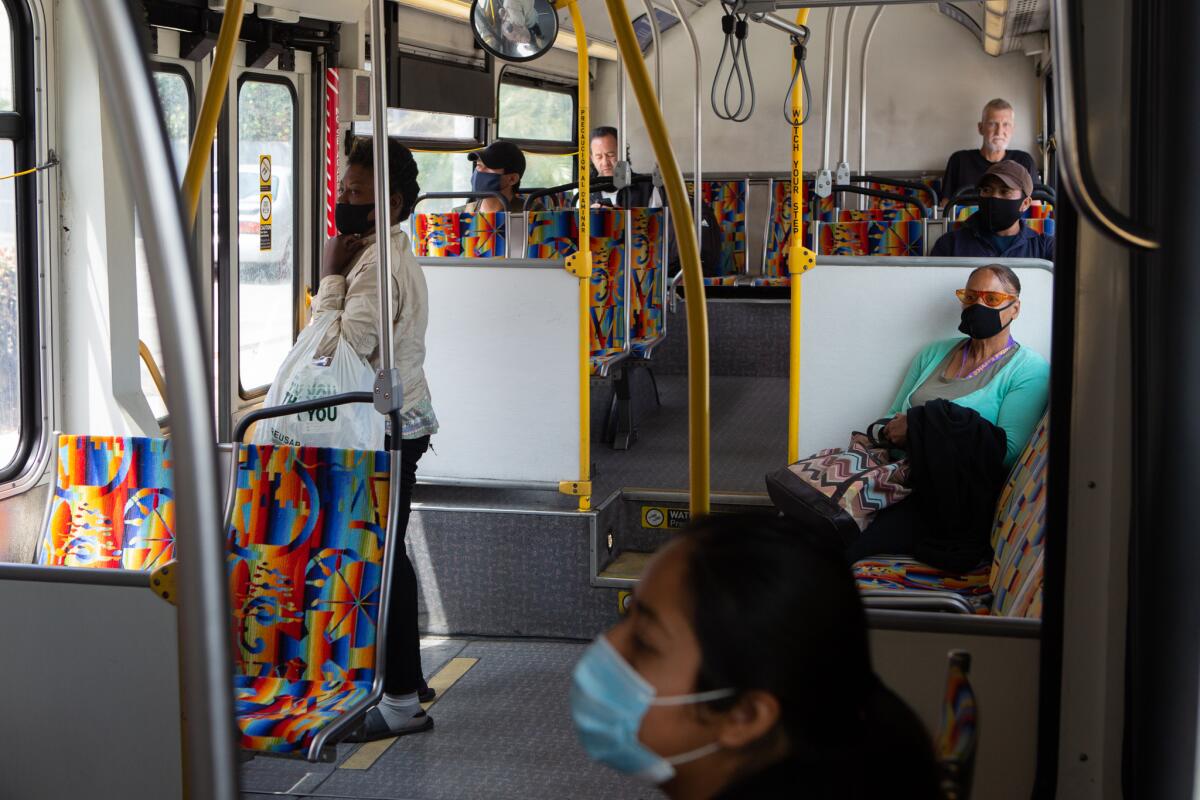Removing Metro fares will make public transit accessible, but it won’t fix bad service

- Share via
In Los Angeles, if you don’t have a car, you take public transit. So for my first two years at Cal State Long Beach, I rode the 577 bus line two hours each way between the school and El Monte Station when I went home to visit family on the weekends. And from home, I would take the Gold Line to downtown Los Angeles for a poetry class on Saturday afternoons.
During the pandemic, however, I joined half of the weekly riders who stopped taking public transit in Los Angeles County. Classes were online, so there was no reason to go out, and my parents were worried I could be infected on buses and trains. Now, as the pandemic is fading, the Los Angeles County Metropolitan Transit Authority is trying out a radical plan to revive its ridership: Doing away with fares for many Angelenos.
Last month the Metro board approved moving forward with a fareless pilot program that would last 23 months and target K-12 and community college students in August before expanding to low-income riders in January 2022. Surveys show that the overwhelming majority of riders are low income; in the fall of 2019, 57% of bus riders as well as 38% of rail riders had incomes below the poverty line.
There is a strong social incentive to make sure public transit provides direct aid to communities that don’t have access to cars and rely on Metro for work and school. And fiscally, it isn’t a bad idea.
For Angelenos, the cost of public transit is paid through sales taxes; Proposition A and C as well as Measure M and R each instituted a half-cent sales tax. In total, 2 cents of every dollar spent on purchases in Los Angeles goes to transit-related costs.
Due in part to Metro’s comparatively low fares, the agency gets less than 5% of its funding from riders. So removing fares would sacrifice an almost negligible amount of revenue and might actually save money because of the fees related to collecting fares.
There are still a number of concerns about the effect of the program on Metro and smaller municipal transit systems in the county. The agency estimates that the pilot program will cost $321 million, which is about 4% of its proposed budget. So it’s good that there’s still some time to flesh out the budgetary concerns before fall rolls around. There are also transportation and infrastructure bills being considered in Congress that could direct more than enough funding to Metro to cover the costs of a pilot program.
Less certain is how Metro plans to address other potential externalities. The initiative might place undue pressure on municipal operators who aren’t following suit, and there are fears homeless encampments could form aboard the shelter of buses and trains during harsher winter weather, necessitating further security.
However, the benefits of a fareless pilot plan to the more than half a million residents of Los Angeles who currently ride Metro are greater than the fears. It will reduce the cost of living by putting money back into the pockets of the poorest Angelenos, and it could help Metro recover ridership levels lost to the pandemic. Having more riders per bus throughout the day could reduce greenhouse gas emissions too.
A 2013 study by the Los Angeles County Department of Public Health revealed that the cost of transit is prohibitive to many students throughout the county. Making transit free could improve attendance and also reduce conflict with law enforcement; notably, the same study showed Black students were disproportionately penalized for fare evasion.
But Eli Lipmen, director of programming and development at MoveLA, argues making transit free won’t solve Metro’s fundamental problems with inconsistent and slow service. “Fare’s a factor, but we’re as concerned about, ‘Is my bus going to arrive on time? Is it going to be fast? Is it going to be reliable?’ ” Lipmen said in an interview.
Alongside the Fareless System Initiative, Metro is ambitiously looking to overhaul its service. It’s already investing in the “28 by 28” plan; 28 capital projects to prepare for the 2028 Olympic Games in Los Angeles. But some researchers are not convinced this is a smart move.
Thomas Rubin has spent more than 40 years running and advising transit agencies in Southern California and throughout the United States. He and fellow researcher James Moore, a professor at USC’s Viterbi School of Engineering and Price School of Public Policy, have criticized LA Metro’s “28 by 28” plan.
Rubin is adamant that constituents are not served by large capital investments. His research with Moore demonstrates that overall, ridership levels fall when Metro invests in railroads and fails to keep up services for buses; more than two bus riders are lost to every added rail rider.
“There’s a very small number of people who live close to a rail line,” Rubin said in a recent interview. “There’s something like 100 [train stations] in L.A. County [as] opposed to 13,000 bus stops.”
But there are political reasons why it’s easier for Metro to get funding for large rail projects rather than bus service updates. “Elected officials sitting on the Metropolitan Transit Authority board want something to claim as a contribution to their constituents, and most often that something is a piece of a train. It’s not very sexy to point at a bus,” Moore said.
For a county that’s as large as Los Angeles, it’s logistically difficult if not impossible to create a rail system that can connect multiple central business districts to sprawling suburbs. It’s why buses are relied on to transport most people between home and work. Metro is rolling out a new bus service plan this year that’s designed to address some of the system’s shortcomings by simplifying bus routes and placing each stop farther apart to increase speed and efficiency.
Brian Taylor, the director of the Institute of Transportation Studies at UCLA, thinks that Metro’s data-based improvements to its bus routes are a promising way to revive ridership by reallocating service. Increased service frequency, decreased wait times, investments in the safety of bus stops such as lighting and added shelter could attract more ridership than free fares, Taylor said in an interview.
“A clear, legible route grid eliminates confusing, circuitous routes and makes it easy for riders to get to most destinations with no more than one transfer,” said Taylor. In general, he said, research shows that riders, even poor ones, are more sensitive to changes in service than changes in price.
But there’s still a trade-off for this improvement. Disability advocates like Cynde Soto, the chair of Metro’s Accessibility Advisory Committee, point out that the updated system that Metro is deploying is less accessible for certain groups of residents. “If you have a mobility disability, especially walking, using a cane, using a walker, people will have to walk and roll farther,” Soto said.
I love riding the buses and trains, it’s how I familiarized myself with the diverse communities and geographies that make up Los Angeles, but I now have access to a car. Most days I’m grateful to avoid the scary nights I waited alone at badly lighted bus stops and the anxiety of planning my schedule around the possibility of tardy service.
While some of us have an option to drive, there’s still a large number of Angelenos who rely on Metro every day for their livelihood, and we should invest in public transit for that reason. What’s clear at the end of the day is that removing fares is just one of many steps toward more equitable mobility throughout Los Angeles County.
More to Read
A cure for the common opinion
Get thought-provoking perspectives with our weekly newsletter.
You may occasionally receive promotional content from the Los Angeles Times.










